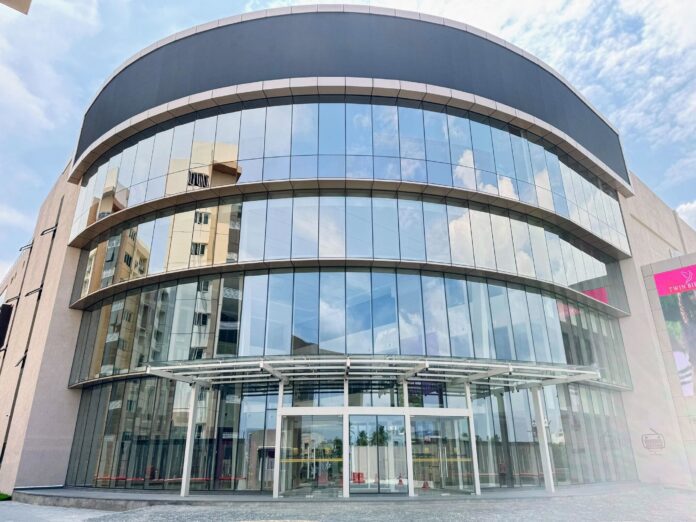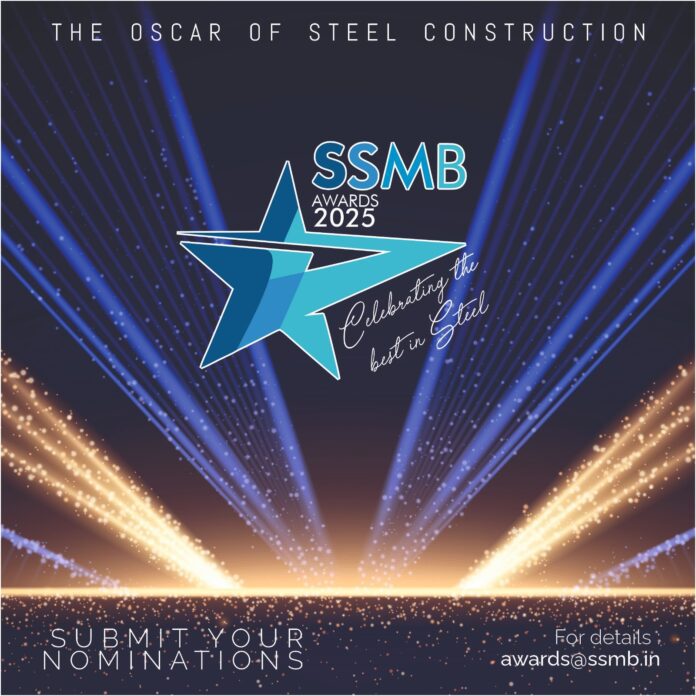Introduction: When Broadway Megaaplex opened its doors to the public, Coimbatore gained not just another entertainment destination but a 400,000 sq ft benchmark in steel construction. Housing South India’s first IMAX Laser and Tamil Nadu’s first EPIQ screen, the project combines cinema, retail, and hospitality in one vertically integrated development. Behind its architectural elegance lies a structural story where steel’s adaptability enabled speed, scale, and precision.
DESIGN & ENGINEERING SYNERGY
Set on a compact urban footprint, the project rises across six levels, including two basements, a ground floor, and three upper floors. The design demanded large column-free volumes, independent vertical circulation for cinema, retail, and hotel components, and integration of services without compromising timelines.
Here, steel became the enabler. Lightweight framing reduced superstructure load on the double basement, minimised foundation pressure, and allowed faster construction cycles. The strategic grid system streamlined coordination between structural design and MEP services, reducing conflicts that often stall large-scale urban projects.
“Steel framing reduced loads on the basement and accelerated construction in a dense urban site.”
CINEMA INNOVATION IN STEEL
The heart of Broadway lies in its nine state-of-the-art auditoria; each designed for acoustic isolation and structural performance.
- IMAX Laser Auditorium: South India’s first, with a 72.5 ft wide screen and 12.1 channel sound.
- EPIQ Auditorium: Tamil Nadu’s first, with a 71 ft wide RGB laser system and Dolby Atmos.
- GOLD Screen: Luxury format auditorium.
- Six additional screens, each equipped with laser projection and Dolby Atmos.
All nine are roofed with double-pitched steel trusses, spanning significant widths without intermediate supports. This not only created expansive, column-free spaces but also enabled effective acoustic insulation, a technical triumph in multiplex engineering.
As Dr. L.S. Jayagopalan, MD, Mithran Structures, reflects:
“The Broadway Megaaplex is proof that lightweight, optimised steel framing can deliver not only architectural drama but also unmatched technical efficiency in dense urban sites.”
RETAIL & HOSPITALITY INTEGRATION
The project extends beyond cinema. 60,000 sq ft of retail space, including a 15,000 sq ft anchor store, demanded flexible spans and robust load-bearing design. Above it, the hospitality zone integrates a 38-key hotel, a 300-seat banquet hall, a multicuisine restaurant, and a restobar.
Each of these functions introduced different structural demands from high live loads in banquet areas to acoustic separation from cinemas. Steel’s modular adaptability allowed these diverse requirements to be addressed within one cohesive framework.
“The floating roof is both structural ingenuity and architectural theatre.”
PARKING & VERTICAL PLANNING
Two basement levels house efficient parking solutions. Basement 1 offers double-height clearance to accommodate future stack parking, while Basement 2 caters to standard parking and services. Ramp design, fire egress, and mechanical ventilation were meticulously engineered, ensuring peak-hour traffic could be managed without congestion.
STRUCTURAL INNOVATIONS
- Theatre Roof Trusses:
Double-pitched trusses enabled broad spans and acoustic integrity while keeping steel consumption as low as 12 kg/sq m — an indicator of optimised, economical design.
- Glass Façade & Circular Girder:
An 18 m tall glass façade, framed in steel box sections, creates a striking frontage. Vertical mullions connect to a 32 m circular girder that absorbs lateral forces but carries no gravity load, a subtle yet brilliant feat of structural clarity.
- Floating Roof Concept:
Perhaps the most dramatic innovation, the 24 m radius floating roof appears to hover above the multiplex. Supported peripherally by steel framing and cantilevered lattice girders, it integrates pantry and storage within its depth. The column-cantilever joint was specially designed to provide horizontal support for façade mullions while allowing vertical sliding, eliminating unwanted load transfer.
“At just 12 kg/sq m, the steel consumption demonstrates optimized efficiency.”
OPTIMISED FRAMING & LOAD MANAGEMENT
Deep lattice girders (3 m) carry both vertical loads and services. By extending overhanging spans, the design reduced load on the 30 m curved lattice and peripheral girders. The roof deck combines steel beams with overlaid concrete, achieving lightweight strength with integrated utility routing.
The most complex challenge lay in connection detailing: joints had to support horizontal forces while allowing vertical movement. The solution became a benchmark in multiplex design, where structural ingenuity directly elevated architectural expression.
Floating Roof Ingenuity
The floating roof of Broadway Multiplex is a story within the story.
- Span: 24-metre radius
- Support: Peripheral steel framing + cantilevered lattice girders
- Innovation: Special joint design allowing horizontal support without vertical load transfer
- Utility: Integrated pantry and storage within roof depth
- Impact: Large column-free space with dramatic visual lightness
Broadway in Numbers
- Total Built-Up Area: 400,000 sq ft
- Levels: 2 basements + ground + 3 upper floors
- Auditoria: 9 (IMAX, EPIQ, GOLD, + 6 standard)
- Retail: 60,000 sq ft
- Hospitality: 38-key hotel, 300-seat banquet, restaurant & restobar
- Steel Consumption: 12 kg/sq m
- Glass Façade Height: 18 m
CONCLUSION
The Broadway Megaaplex more than an entertainment hub, is a technical landmark. By combining lightweight steel framing, precise lattice innovations, and advanced façade engineering, the project redefines what multiplex design can achieve in India.
It demonstrates that when architects, builders, structural engineers and the developers, in this case VRR Satish Kumar, Managing Director of Broadway Megaaplex, work in synergy, steel can deliver speed, span, and spectacle without compromising efficiency. For Dr. Jayagopalan and his team at Mithran Structures, Broadway is not just a completed project — it is a case study in structural innovation that will inspire multiplex and mixed-use developments for years to come.
|
Lessons for Future Projects – Insights from Broadway The Broadway Multiplex is a case study in how steel can redefine urban mixed-use developments. Dr. L.S. Jayagopalan emphasises that the technical and collaborative strategies adopted here can serve as guiding principles for future cinema, retail, and hospitality projects. 1. Optimise Steel Consumption Broadway achieved 12 kg/sq m of steel usage, a benchmark in efficiency. Careful framing plans, lattice girders, and load-sharing systems reduced material without sacrificing strength. Future projects should prioritize optimization rather than overdesign. 2. Prioritise Acoustic & Structural Integration For multiplexes, acoustics are as critical as structure. The use of double-pitched steel trusses enabled long spans while also supporting acoustic isolation. Early coordination between structural and acoustic teams is essential. 3. Leverage Prefabrication & Modular Strategies Prefabricated steel elements shortened construction timelines in a congested urban site. Modular strategies also minimised disruptions, allowing MEP services to be seamlessly integrated. 4. Design for Multi-Functionality Broadway combines cinemas, retail, hospitality, and parking in one vertical stack. Each use required different load and vibration criteria. Steel’s flexibility allowed tailoring of structural solutions for each function within a unified design. 5. Innovate in Connection Detailing The “floating roof” succeeded because of a special joint system that resisted horizontal loads while allowing vertical sliding. Innovation in connections is where structural breakthroughs often happen. |




